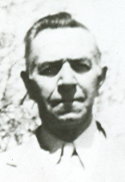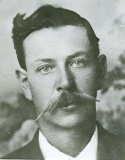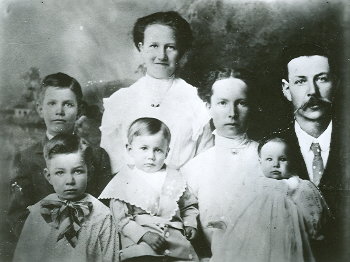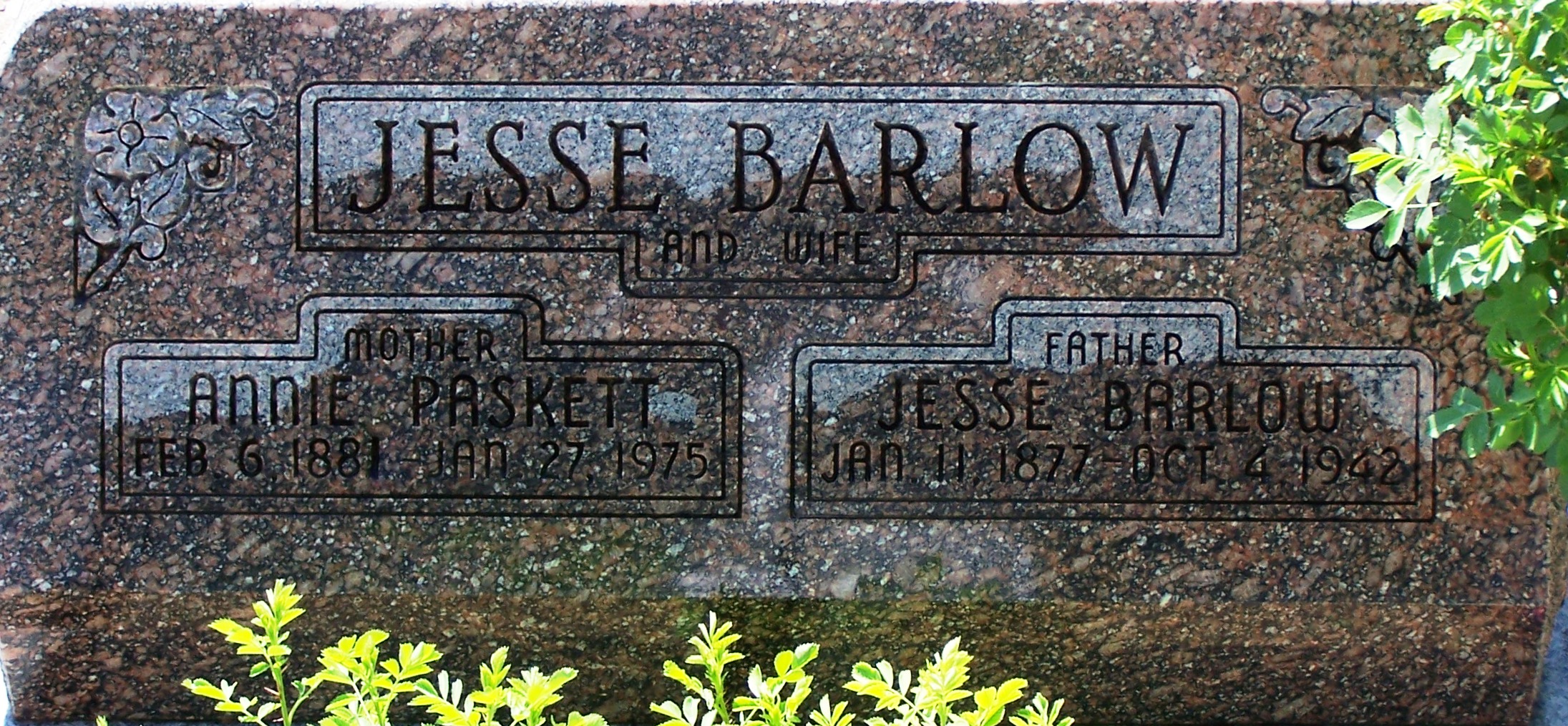
 In a little one room adobe house in Fairfield, Utah County, Utah, Jesse Barlow first saw the light of day. His father, Joseph Smith Barlow had died just six months before at the age of twenty-eight years. Jesse’s father had been weakened by hardships encountered while crossing the plains in 1856 in the Martin Handcart Company. He walked most of the way. Jesse’s mother, Amanda Morgan Barlow was left a widow at the age of twenty-four years, with three other children. Joseph was seven, the oldest in the family and Alice and Mary Emily were the other two.
In a little one room adobe house in Fairfield, Utah County, Utah, Jesse Barlow first saw the light of day. His father, Joseph Smith Barlow had died just six months before at the age of twenty-eight years. Jesse’s father had been weakened by hardships encountered while crossing the plains in 1856 in the Martin Handcart Company. He walked most of the way. Jesse’s mother, Amanda Morgan Barlow was left a widow at the age of twenty-four years, with three other children. Joseph was seven, the oldest in the family and Alice and Mary Emily were the other two.
Jesse was born on January 11, 1877 and was christened by Joseph Morgan on February 18, 1877.
Young Jesse was blonde when he was little. His hair was white with one black streak in it. In later years when his hair went dark, this one streak was lighter than the rest and quite noticeable. His sister, Alice, used to scrub vigorously in an effort to make the black streak white like the rest of his hair.
While still very small, his mother took him to Grouse Creek, Box Elder County, Utah in 1882. The whole Morgan family moved out to Grouse Creek and located farms, using the “Squatter’s Rights.” Grandfather Morgan’s place was where Charles Toyn’s house is located in the north end of the valley. They lived in a log room near the stone school that was built later. The log house was the schoolhouse and they lived in it at the time. In the winter the snow was too deep for the children to walk through. The family returned to Fairfield, with exception of Jesse Morgan, and lived there until 1885.
 When Jesse was five years old, he went with his mother to visit his Uncle David Morgan in Park City, Utah. He remembered everything about it. Uncle David built the third house erected in Park City.
When Jesse was five years old, he went with his mother to visit his Uncle David Morgan in Park City, Utah. He remembered everything about it. Uncle David built the third house erected in Park City.
Jesse remembered Camp Floyd very well. It was situated at Fairfield, Utah. Their house was just three blocks from Old Camp Floyd, where Johnston’s Army made their headquarters after they were permitted to pass through Salt Lake City. As a youngster, Jesse and his sisters used to run around on top of the adobe wall of Old Camp Floyd.
While still at Grouse Creek on his first trip, Jesse became so ill with diphtheria that his mother laid him out on a table for dead. This epidemic was so severe that several children died of it.

Roy, Lester, Francis, Emma, Annie, Adella and Jesse Barlow
At that time the parents had to pay tuition for their children to go to school. Sometimes Amanda didn’t have the means to pay.
Jesse liked horses and loved to ride them. He became one of the best riders and ropers in his day. He said he would “walk three miles to ride one.” He liked all kinds of livestock but when he was very young, they had none of their own.
One time Jesse ran away and followed a band of sheep as it went through Fairfield. One sheep herder gave him a blue billy goat. Amanda had no feed for the goat so they had to get rid of it.
Grandfather David Morgan and Joseph, Jesse’s brother, went to Grouse Creek, Utah from Fairfield in 1884 and stayed until 1885. Uncle Jesse Morgan and Joseph Barlow went back to Fairfield in 1885 and took the family out to Grouse Creek in 1886. The trip was a long and tiresome one. They started with two wagons on January 28, 1886 and drove to Slaytown that day. Another days drive took them to Grantsville where they stayed with Dave and Maggie Douglas. From Grantsville they drove to Cooks Canyon on Grassy Mountain, straight south from Lakeside. The fourth days’ journey took them to Newfoundland and next to Bovine, where they got stuck in the mud. They left one wagon mired in the mud and returned for it the next June. The alkali looked dry but wasn’t. Alice started to walk one day and sank into the mud. The others had to rescue her.
Amanda Morgan Barlow moved to Grouse Creek because of necessity, but she had a warm spot in her heart for that place because, as she said: “They never suffered from hunger there.”
Emily, Alice and Jesse all told how their mother kept them off the streets by having them sew a ball of carpet rags a day. Jesse disliked this very much. Lottie Paskett, Emily, Emma Paskett and Molly Toyn would come and help the Barlow children sew their daily ball of carpet rags so they could finish sooner and go out to play.
First the Barlows lived where George Blanthorn Jr. has his ranch, which is north of where the Paskett home was located. Several families lived there and it was called “Poverty Flat.” Later Amanda moved to the ranch at Death Valley, west of Grouse Creek. This was in April 1887. She moved here to keep house for Valison Tanner and she married him in October 1887. Her home was a two-room log house with a clay roof. Jesse said Val was a good stepfather, he was free-hearted and didn’t have a dishonest hair in his head. He was somewhat gruff, but was a good man.
At that time a tribe of Ute Indians lived at Grouse Creek both summer and winter. The children liked to visit their camp. One day the big boys wouldn’t let Jesse play with bows and arrows so an old squaw, named Nancy, made a bow for him. In order to roll the sinew for the bow string she pulled up her skirts and rolled the sinews on her bare leg. She made several arrows with feathers and Jesse was the envy of the others because of his having these bows and arrows.
When Jesse was fourteen years old, he broke his arm when riding his horse, “Tiboe.” After thirteen weeks it hadn’t mended so his mother took him to Ogden for medical attention. The accident happened when he was “cutting” a steer from the herd and a ditch bank gave way, letting his horse fall. Not so long after this he had another accident with a horse in Bluff Creek, Nevada, where his chest was caved in and he suffered from this the rest of his life. This happened about 10:00 in the morning. He regained consciousness about 4:00 p.m. and arrived home at midnight.
Jesse started working for wages at the age of twelve. He ran the hay rake and wagon for Fletcher on Lower Etna Creek. He was herding horses at the age of fifteen.
He liked Annie Paskett real well and began keeping company with her when both were very young, keeping steady company for four years. They both liked to dance. They went for horse back rides and buggy rides in Allan Tanner’s new black, square topped buggy. In 1899 on the 8th day of November, they were married in the Salt Lake Temple by President John R. Winder. His mother and stepfather, Valison Tanner accompanied them to Salt Lake City and went through the temple with them. Jesse was nearly twenty-three and Annie was nearly nineteen.
The first year of their married life was spent at the Mecham ranch, later known as the Dell Hart ranch, which is on the west side of the valley and about a mile from Death Valley narrows. The next spring Jesse, with the help of his brother Joseph and Arthur Richins, built a log house on what has been known as the Barlow ranch at Etna, Utah, south of the Warburton rock house. The new home built of logs consisted of two rooms and a porch and had a clay roof. Later two more rooms and a cellar were added.
Emma was born soon after they moved into this house. Her birthday was on August 9, 1900. Their first son, Roy Jesse was born on November 9, 1902. Melvin was born on June 28, 1904 and died six hours later, a premature baby. Joseph Lester was born on April 16, 1906. Francis was born on November 7, 1908. Adella was born on December 18, 1910 and Louise was born on February 4, 1913. Sidney Raymond arrived on November 24, 1914 and lived but three months. He died of pneumonia. Inez LaVern, the youngest, was born on January 27, 1916.
Jesse was a good cook. He first started cooking when his mother was ill the winter after Uncle Val died. He and Joseph, his brother, took turns doing the cooking, dish washing and other housework. Olive was ill as a baby and Amanda, his mother, was also ill. He could make excellent sour dough bread and yeast bread likewise. He could make good cakes and other tasty dishes. He had a special way of cooking meat, which made it very delicious.
When Emma was a baby, Jesse took Val Tanner’s new wagon with a load of wheat to the mill. His wife went to stay with her parents while he made the trip. He drove a four-horse team. Two of the horses were not thoroughly broken. As he approached the summit of the mountain, Jim Shaw suddenly appeared riding a white horse. This frightened his horses and they ran, tipping the wagon over and smashing it. Fortunately he was not hurt. Jim Shaw helped him collect the load and get back home. Richard Warburton was a good blacksmith and helped him repair the wagon.
Jesse worked for wages much of the time after he was married. He worked for Eager and Parsons and for Miller and Lux and for the Winecup Outfit. He worked with livestock or in hay fields or anywhere work was available to support his family. He loved and knew horses. He knew most of the Grouse Creek and Etna horses, their personalities and their reputations.
“Chester” was one of Jesse’s favorite horses. He was a chestnut sorrel, mean to strike and kick but a good horse. “Sailor” was another of his favorite mounts. He was a dark buckskin with a dark stripe down his back, an exceptionally well reined horse but apt to strike. Jesse cautioned his boys not to get near Sailor or Chester. “Fox” was his all-time favorite, a little white horse and one of the cow horses that was ever in that area.
Jesse kept Fox until he died of old age, which was about twenty-five years. This horse died in the winter when the snow was very deep. Fox was very gentle and Roy rode him. Fox wouldn’t step over a rope lying on the ground. “Prince” was another favorite. He was dark brown and high spirited. Once Jesse dropped one of his bridle reins and Prince bucked him off and injured him for several days.
Jesse acquired some livestock of his own, mostly horses. In order to take care of them he would have to break his horse early in the spring and take cattle to the ranch, meaning a lot of hard work. The cow pony had another job when fall came. The horse was taught to hold down calves when they were being branded.
Jesse broke many horses to ride and to work. He took pride in a good pulling team and a good riding horse.
In 1916 he purchased a Dodge automobile, his first car, which he drove for ten years.
Jesse did leather work for a hobby. He was very good in leather craft. He made bridles, halters, quirts, hair ropes from horse tails and many other articles used on a ranch. He was handy in the blacksmith shop, in fact his suppressed desire was to be a blacksmith. He was very adept at making things from wood or steel and repairing things.
“Quart” Catlin, a brother-in-law to Lindy Kimber, was Jesse’s age and one of his many friends. There were several Catlins -Charlie, Lou, Bill, Quart, and Floyd. Charles Lucas was one of his friends as also was Perry (Pell) Fenstermaker.
One day when Jesse was about fifteen years old, Charles Lucas asked him to get on his horse and ride to “Pell” Fenstermaker’s on Meadow Creek and warn him that the peace officers were after him. They were supposedly going to arrest Pell for alleged horse stealing. His friends wanted to warn him so he could hide out. Jesse rode at night and warned him and the officers didn’t get Pell. Pell’s ranch was some twenty miles away.
Charles taught Jesse how to butcher and he became a very good butcher. Ray Brizzee was one of his friends and was raised on the Ernest Warburton ranch. Also Coleman Rouse and Joe Rouse who lived at Terrace, Utah in the early days were counted among his friends.
Jesse worked for the Wine Cup outfit in Nevada with Clark Parkinson. Then the Miller and Lux outfit came into the Grouse Creek area. Bert Cottle was foreman and a great friend of Jesse’s. Jesse had many friends in Oakley, Idaho and Dave James of Park Valley was a good friend.
In 1930 Jesse was awarded a four-year contract to carry U.S. mail from Lucin to Grouse Creek via Etna. Roy and Nell Lovell were married in 1930 and took up residence in Lucin where Nell took over the Post Office.
In 1933 there was a lot of snow and it was known as a bad winter. The snow was so deep that they had to use teams of horses on both ends of the line to get the mail through. This was a big responsibility, but Jesse did a good job. He probably did not break even on expenses that winter.
Jesse was very good at shoeing horses and fitting shoes. He could shoe children too. He repaired many shoes for children.
During the latter part of Jesse’s life he suffered tremendously due to a gristly growth between the lower vertebra on the spine. When this growth would swell or grow any larger he would lose the use of his legs, and because of this he took many a hard fall. He suffered with this for fifteen years or more. It was brought on by injury to his back when he was younger through accidents riding horses and a bad fall from a load of hay when the horses bolted and began to run away. He had several serious injuries which combined to make his later years a time of suffering, but he never complained. He said: “It feels like a hot iron in my back all the time.”
Jesse had an abiding testimony of the gospel. He always paid his tithing. He was largely responsible for keeping his older brother Joseph on a mission to England in the early years of the century and he, with the help of his immediate family, kept Roy on a mission to the Eastern states in 1924. He also did what he could to assist his son, Lester, on his mission in 1933 to 1935.
Jesse was ordained a Seventy about 1920. He was called on a short stake mission to Malta, Idaho. He rode “Prince,” his favorite horse, to Malta and when he returned several weeks later, the snow was so deep that he was forced to return via Park Valley, Utah.
Jesse was liked by all the children. He had a magnetic influence with them. He was devoted to his family and had a reputation for honesty and integrity. It was said of him that “his word was as good as his bond.”
Jesse died on October 4, 1942 with cancer of the stomach. He was conscious up to the last. He set a marvelous example of honesty, integrity, dependability and forthrightness to his family and all who knew him. He is buried in the Grouse Creek Cemetery.

